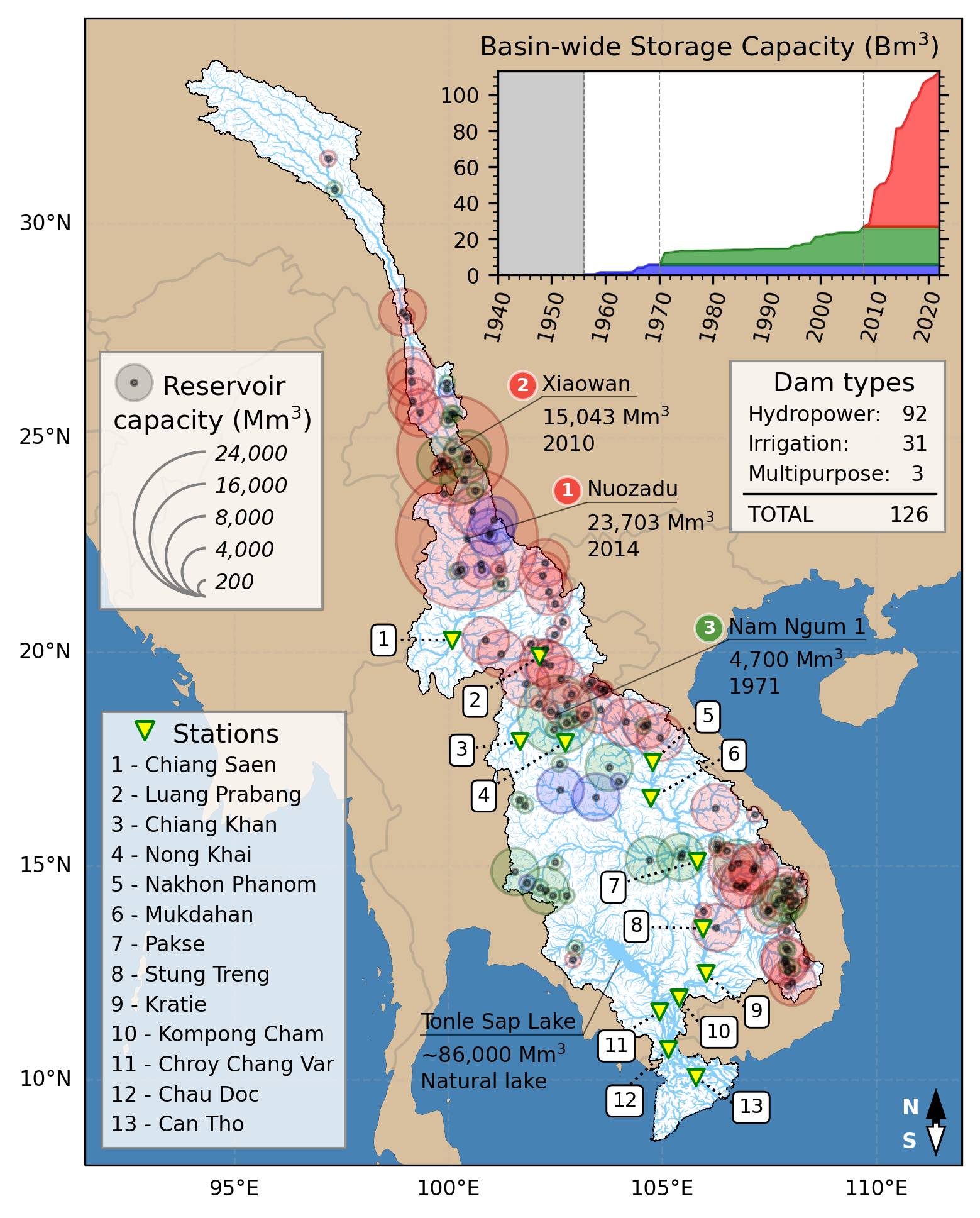MCW Hydrology
MCW Hydrology of the Mekong, led by Dr. Yadu Pokhrel and PhD student Huy Dang, studies the hydrology of the Tonle Sap Lake (TSL) in Cambodia. The TSL is Southeast Asia’s largest inland lake that supports one of the world’s largest inland fisheries, which has seen substantial hydrological changes in recent decades, impacting both the socioeconomic and environmental conditions of the region. These adverse impacts are related to the changes in the Mekong mainstream flood pulse due to both natural climate variation and the booming number of upstream dams. As shown in the figure below from Dang & Pokhrel, 2024, the basin-wide man made water storage capacity has increased sharply since 2010. As of 2022, the total storage capacity of large dams has almost quadrupled the number from previous decades. While the dams have benefited communities in the Mekong River Basin (MRB) by increasing the region’s overall capacity for irrigation, water resources management, and power generation, there are growing concerns that the operation of these dams in combination with climate change is causing fundamental shifts in the hydrology and inundation dynamics of the TSL.

The main objectives of our studies include:
-
Examining the historical changes of the Mekong mainstream’s flood pulse.
-
Quantifying the dam-induced alterations in the TSL water balance.
-
Investigating the changes in flood occurrences in and around the lake.
To replicate the historical hydrological conditions of the MRB, we have implemented a modeling framework based on CaMa-Flood-Dam, an enhanced river-floodplain hydrodynamic model considering optimized dam operation. The model computes daily river-floodplain hydrodynamic properties (i.e., river discharge, water level, and inundated areas) of the entire MRB at ~5km resolution (inundation depth is downscaled to a higher resolution of ~90m) under the following settings: (1) without dam operation (NAT), and (2) with optimized hydropower and irrigation dams based on their commissioned year (DAM). In 2022, the simulation only covers 38 years between 1979 – 20162 due to limitation in the input dataset. However, in 2024, we have expanded the simulation period to 83 years between 1940 – 20221, providing critical information of the basin’s hydrodynamic in the past.
The main key findings in our studies are as follows:
-
While climate variability has been a key driver of the inter-decadal variabilities in the lake’s hydrology, the Mekong dams have exerted a growing influence over time—more pronouncedly after 2010—on the Mekong flood pulse, the Tonle Sap River flow reversal, and TSL water balance and its inundation dynamics.
-
Dams dampened the annual amount of water exchange between the TSL and Mekong mainstream, especially in the 2010s, and the inflow from the Mekong to the TSL was reduced by 10-25%.
-
Dams are largely altering the seasonality of the MRB’s flow regime by redistributing a substantial amount of water (~10-20% annual volume) from the wet season to the dry season.
-
With the reduced peak flood and increased low flow from upstream dam operations, the inner area of the TSL stays inundated longer, while the outer peripheral area is drained more quickly. The annual inundated duration of this area is reduced by ~15 days, which effectively shrinks the lake’s seasonally inundated areas.
If you are interested in these works, you can find more information in our peer-reviewed publications:
- Dang, H. & Pokhrel, Y. Evolution of river regime in the Mekong River basin over eight decades and role of dams in recent hydrologic extremes. (2024) doi:10.5194/egusphere-2023-3158.
- Dang, H. et al. Hydrologic balance and inundation dynamics of Southeast Asia ’ s largest inland lake altered by hydropower dams in the Mekong River basin. Science of the Total Environment 831, 154833 (2022). https://doi.org/10.1016/j.scitotenv.2022.154833
